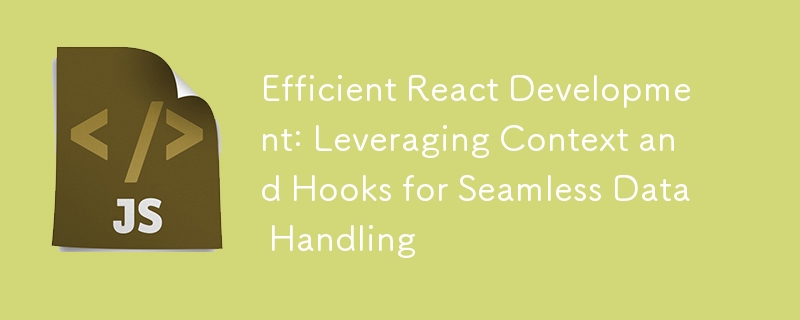高效的 React 開發:利用上下文和 Hook 進行無縫資料處理
- WBOYWBOYWBOYWBOYWBOYWBOYWBOYWBOYWBOYWBOYWBOYWBOYWB原創
- 2024-08-26 21:47:06442瀏覽

介紹
React 的 Context API 允許您在應用程式中全域共享數據,而 Hooks 提供了一種無需類別元件即可管理狀態和副作用的方法。它們共同簡化了資料處理並使您的程式碼更易於維護。在本文中,我們將深入研究 React Context 和 Hooks,提供詳細的逐步範例,幫助您理解並在專案中無縫實現這些功能。
什麼是 React 上下文?
React Context 是一個強大的功能,可以在元件之間共用值,而無需進行 prop 鑽取。它提供了一種透過元件樹傳遞資料的方法,而無需在每個層級手動傳遞 props。
React Context 的主要優點
- 簡化狀態管理:無需將道具傳遞多個層級。
- 提高程式碼可讀性:讓您的元件樹更清晰。
- 鼓勵可重複使用:上下文值可以在應用程式的不同部分輕鬆重複使用。
什麼是 React Hook?
React Hooks 可讓您使用狀態和其他 React 功能,而無需編寫類別。 Hooks 在 React 16.8 中引入,為您已經了解的 React 概念提供了更直接的 API。
常用掛鉤
- useState:管理功能元件中的狀態。
- useEffect:處理功能組件中的副作用。
- useContext:存取 Context 的值。
設定 React 項目
在我們深入實施之前,讓我們先建立一個 React 專案。如果您還沒有,您可以使用 Create React App 建立一個新的 React 應用程式:
npx create-react-app context-hooks-example cd context-hooks-example npm start
這將設定一個新的 React 應用程式並啟動開發伺服器。
建立上下文
讓我們從建立一個新上下文開始。對於此範例,我們將建立一個簡單的上下文來管理使用者的資訊。
// src/UserContext.js
import React, { createContext, useState } from 'react';
export const UserContext = createContext();
export const UserProvider = ({ children }) => {
const [user, setUser] = useState({ name: 'John Doe', age: 30 });
return (
<UserContext.Provider value={{ user, setUser }}>
{children}
</UserContext.Provider>
);
};
在上面的程式碼中,我們建立了一個 UserContext 和一個 UserProvider 元件。 UserProvider 元件使用 useState 鉤子來管理使用者的訊息,並將使用者狀態和 setUser 函數作為上下文值傳遞。
在元件中使用上下文
現在我們已經設定了上下文,讓我們在元件中使用它。
存取元件中的上下文
要存取元件中的上下文,我們使用 useContext 鉤子。操作方法如下:
// src/components/UserProfile.js
import React, { useContext } from 'react';
import { UserContext } from '../UserContext';
const UserProfile = () => {
const { user } = useContext(UserContext);
return (
<div>
<h2>User Profile</h2>
<p>Name: {user.name}</p>
<p>Age: {user.age}</p>
</div>
);
};
export default UserProfile;
在此範例中,UserProfile 元件從上下文中存取使用者資訊並顯示它。
更新上下文資料
為了更新上下文數據,我們使用上下文提供的 setUser 函數。
// src/components/UpdateUser.js
import React, { useContext } from 'react';
import { UserContext } from '../UserContext';
const UpdateUser = () => {
const { setUser } = useContext(UserContext);
const updateUserInfo = () => {
setUser({ name: 'Jane Doe', age: 25 });
};
return (
<div>
<h2>Update User</h2>
<button onClick={updateUserInfo}>Update</button>
</div>
);
};
export default UpdateUser;
在 UpdateUser 元件中,我們定義了一個函數 updateUserInfo,它使用上下文中的 setUser 函數更新使用者的資訊。
整合上下文和元件
接下來,讓我們將上下文和元件整合到主應用程式中。
// src/App.js
import React from 'react';
import { UserProvider } from './UserContext';
import UserProfile from './components/UserProfile';
import UpdateUser from './components/UpdateUser';
const App = () => {
return (
<UserProvider>
<div className="App">
<h1>React Context and Hooks Example</h1>
<UserProfile />
<UpdateUser />
</div>
</UserProvider>
);
};
export default App;
在 App 元件中,我們使用 UserProvider 包裝 UserProfile 和 UpdateUser 元件。這使得上下文可用於 UserProvider 中的所有元件。
常見問題解答
使用 Context API 的主要優點是什麼?
使用 Context API 可以減少對 prop 鑽探的需求,從而簡化狀態管理。它使您的程式碼更清晰、更易於維護,使您能夠有效地跨多個元件共享狀態。
Hooks 如何增強 Context 的功能?
像 useState 和 useContext 這樣的鉤子可以更輕鬆地管理和存取功能元件中的上下文值。與類別組件相比,它們提供了一種更直觀、更直接的方式來處理狀態和副作用。
我可以在單一元件中使用多個上下文嗎?
是的,您可以透過使用不同的上下文物件呼叫 useContext 在單一元件中使用多個上下文。這允許您在同一元件內獨立管理不同的狀態。
如何除錯與上下文相關的問題?
要偵錯與上下文相關的問題,您可以使用 React DevTools,它提供了一種檢查上下文值和元件樹的方法。確保您的提供者正確包裝需要存取上下文的元件。
結論
React Context 和 Hooks 提供了強大的組合,用於管理狀態和跨應用程式傳遞資料。透過遵循此逐步範例,您可以利用這些功能來建立更有效率且可維護的 React 應用程式。請記得使用 Context API 來避免 prop Drilling,並使用 Hooks 來有效管理狀態和副作用。
以上是高效的 React 開發:利用上下文和 Hook 進行無縫資料處理的詳細內容。更多資訊請關注PHP中文網其他相關文章!

